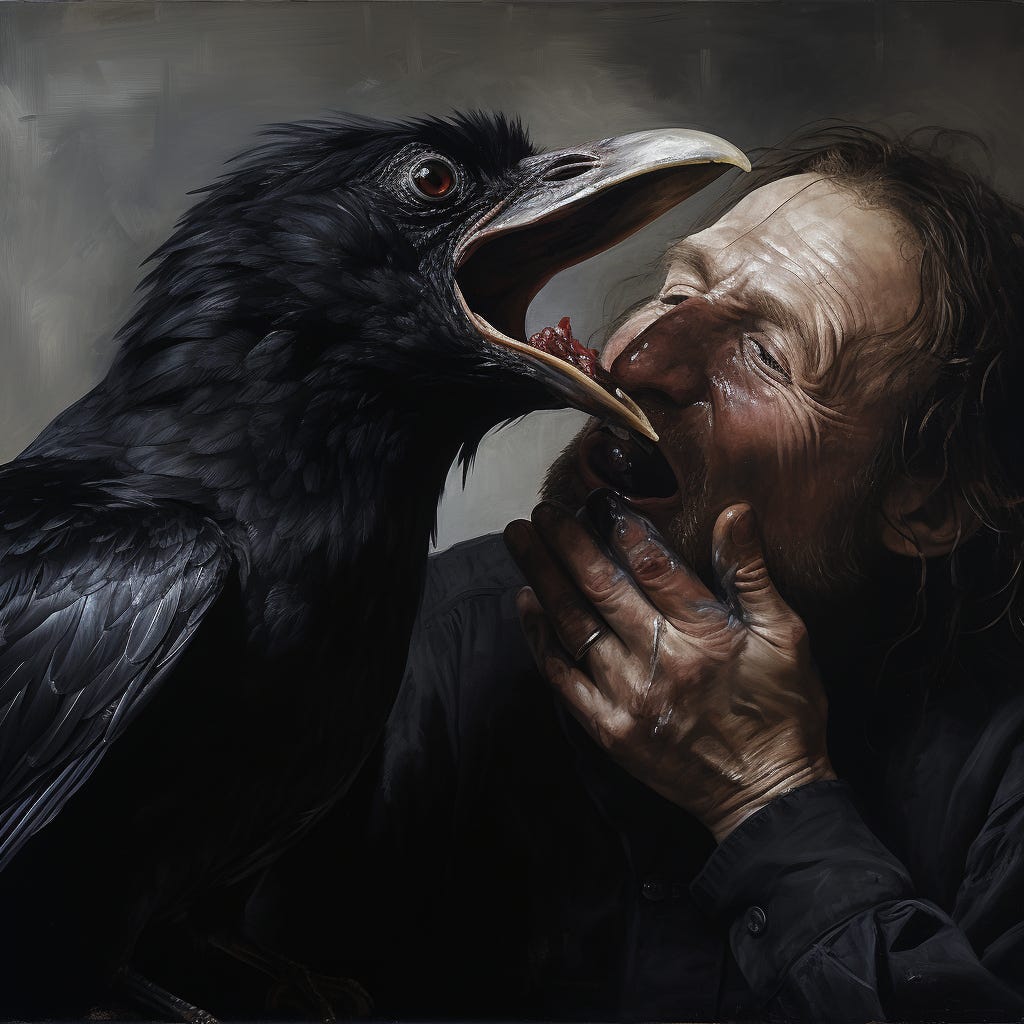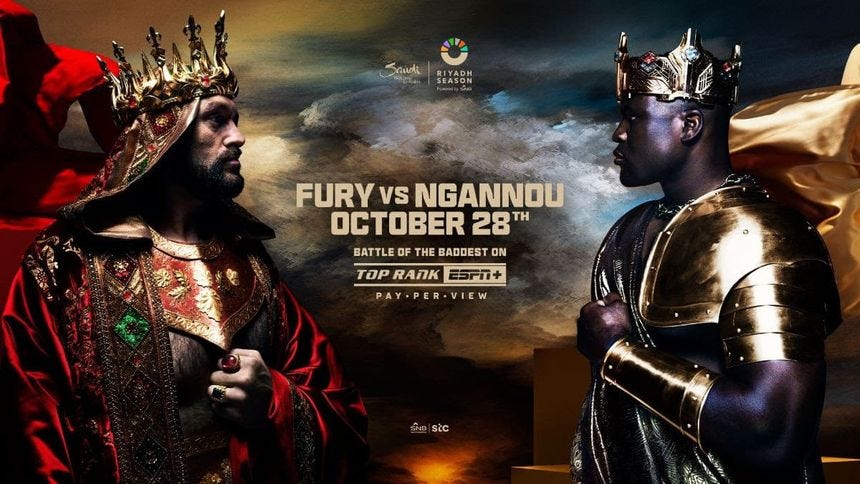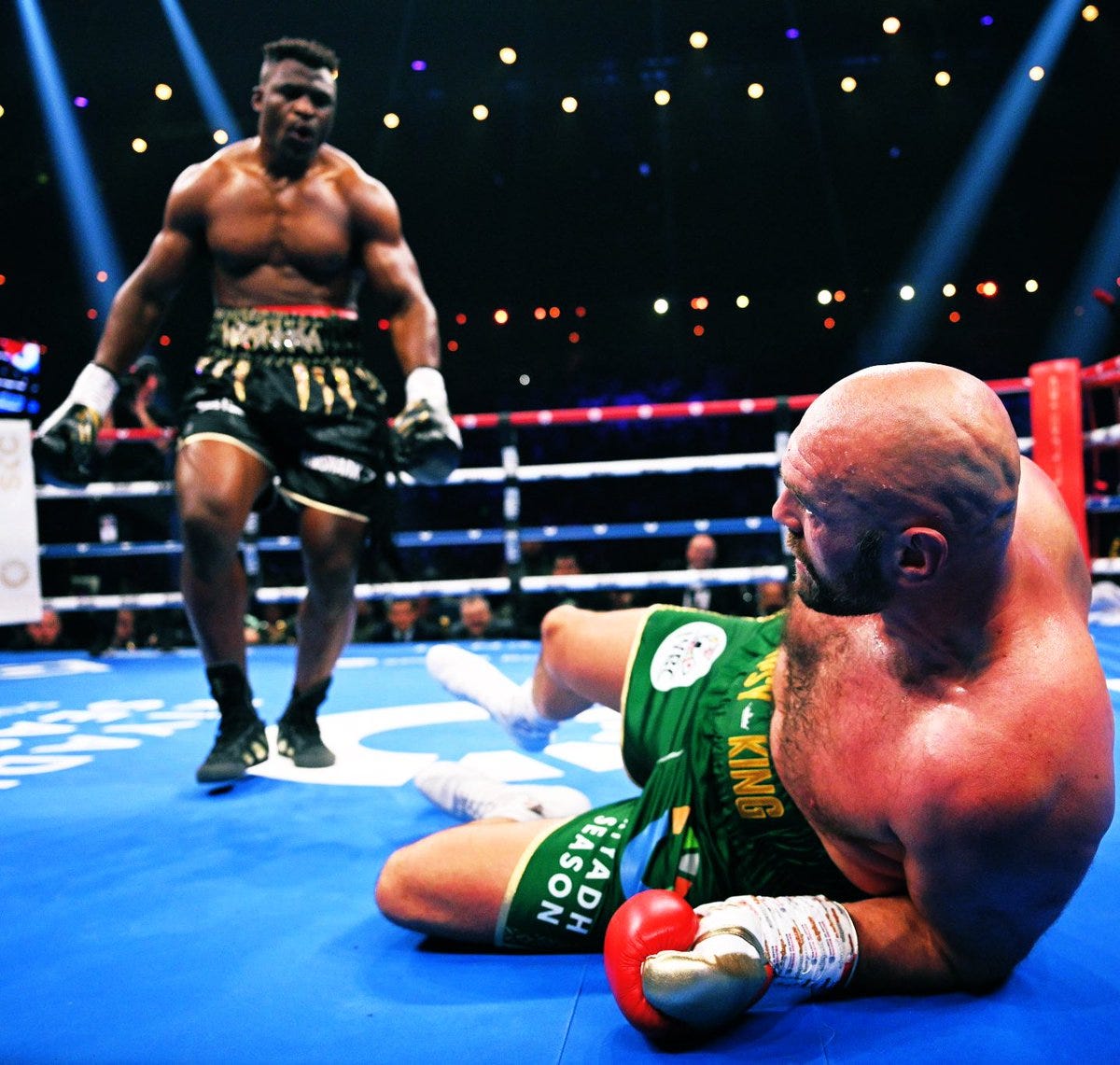Francis Ngannou Shocks the World
I am a Big Fat Idiot
I was completely wrong regarding Francis Ngannou’s chances against Tyson Fury in their Battle of the Baddest this past weekend.
Here’s me eating crow
Before the fight, I wrote this article (linked below) assessing Ngannou’s chances and crafting a potential game-plan for him, informed by his own habits and Fury’s third meeting with Deontay Wilder.
Can Francis Ngannou Do the Impossible?
Francis Ngannou has little more than a prayer of beating Tyson Fury this Saturday in Saudi Arabia. An extremely small sliver of a chance. I will never count a man out, especially one who has grabbed life by the balls and overcome as many obstacles as Francis Nagnnou, but the odds are not in his favor.
Regarding the use of body jab, body work, and the double jab to back Fury against the ropes where Francis can unload, this article was largely predictive. These were real keys to Ngannou’s success. What I was not expecting was a crisp left hook, a superior clinch game, and a sound awareness of ring geography and feints on Ngannou’s part.
Francis Ngannou just did what many consider impossible as he keeps etching his name into combat sports history, accomplishing one of the more impressive feats that combat sports have ever seen.
Disclaimer: The video clips included in this article are not owned by the author. They are included for educational purposes only to illustrate key moments in the fighter’s career and demonstrate aspects of mixed martial arts techniques and strategies. All rights to the video content belong to their respective owners.
Foundation
Francis Ngannou’s weapons in this fight were built upon a solid foundation of boxing fundamentals. Unlike many who simply see their “boxing game” as a series of combinations and punch speed, Francis Ngannou sought to improve the more nuanced skills that being a great boxer requires.
Tyson Fury is a large man with shocking foot and hand speed, much in the same way a bumble bee’s wings should not be able to support the weight of the animal to fly. He certainly had the edge in this department compared to the former UFC champion, but Ngannou did not need to be faster.
Much in the same way that Joe Louis “shuffled” to conserve his energy but maintained his status as a ring general, Ngannou was always looking to establish himself in the center of the ring. Any time his back approached the ropes he side stepped to re-establish his control of the center.
He fought much of the fight from this position, refusing to concede ground to the undefeated boxer and turn with him as he danced around.
Another neat trick that Ngannou employed throughout the fight was his use of the stance switch. Switch hitting is much more common in MMA than it is in boxing, and Francis would occasionally switch stance to give Fury a new look. From the open-stance he would keep his hand on top of Fury’s to obstruct his quick jab and keep him from throwing combinations.
Francis sought to maintain the center and would use this position to back Fury against the ropes or into the corner. With an active lead hand in Fury’s face and insistent body work, Fury’s tendency to move straight back when met with jabs meant that he found himself near the peripherals of the ring quite often. He would be forced to circle out or to clinch, keeping the momentum of the fight firmly within Ngannou’s grasp.
Though he was able to work quite well off the back foot in some rounds, he became overwhelmed with Ngannou’s persistence in others.
Somewhat shocking to see from an MMA fighter was Ngannou’s use of proactive head movement interwoven in his offense. Head movement can be somewhat complicated in MMA due to the various threats, and some use it as an afterthought to their combinations without linking the two together.
Ngannou has obviously trained MANY boxing rounds, as any habits he picked up from MMA sparring were eliminated in favor of a style more suited to boxing.
With this foundation set underneath, Ngannou was able to use a few weapons in a variety of ways. His approach nwas simple and multi-pronged. Only focusing on key weapons and building off of them, Ngannou was able to surprise Fury and the whole world with his performance against the Gypsy King.
Jab
Picking up where Deontay Wilder left off, Ngannou’s body jab was his most consistent weapon against Fury. To reiterate why it is so effective against him:
Tyson Fury has a large body, and thus a large target
Power punchers will always hit hard, and jabs to the body will tire out an opponent as they accumulate throughout the fight.
Dipping with the body jab keeps his head off the center line
Varying the jabs target makes power punches easier to set up as the opponent stays guessing as to where the jab is going to go
The range advantage Fury has, along with his head movement, means that his body will be much slower and easier to hit than his head.
Ngannou did a wonderful job of maintaining an active lead hand. Even if he was not throwing with full commitment, he kept his jab active and in Fury’s face. Fury would respond by either backing up or throwing to return. In many instances, Ngannou was able to counter Fury’s return, such as below where he slipped another solid body jab under Fury’s lead hand. A nice weapon in the open-stance matchup.
As Ngannou established the body jab, he was able to mix it into his double jab combinations. Immediately to start the third round, Ngannou fakes the jab high and sinks another one right into Fury’s gut.
The body jab might not look like much, but it wears the body over time and is something that the opponent has to address, especially when the man on the other hand is a hulking 274 lb beast.
Ngannou was able to reliably build off of his double body jab and throw extended combinations. Even when he begins his combinations he does not start head-hunting, as each punch thrown is to a different target.
Varying the jab’s target keeps the opponent’s guard moving rather than pinned to one place. He wasn’t able to cleanly land in this instance, but he was not leaving himself open and he was showing Fury various looks. No doubt Fury was not expecting this level of craft so early in the bout from Francis Ngannou.
A surprising wrinkle to Francis Ngannou’s performance was his consistency. Like fellow Xtreme Couture product Sean Strickland’s performance against Israel Adesanya, Ngannou was able to maintain his composure and stick to his key weapons throughout the fight.
Even as Fury attempts to counter Ngannou’s jab with a flurry of punches, Ngannou returns to the jab just a moment later to push Fury to the ropes and leave little openings.
Just as Wilder did to Fury, and Ngannou to Stipe Miocic in MMA, the double jab is one of the most reliable tools a fighter can add to their tool-set. Fury, like many MMA fighters, has a tendency to move back in straight lines in response to his opponent’s jab.
As Ngannou maintained control of the center, a double jab is able to move Fury directly to the ropes where Ngannou can follow up with an overhand right. The double jab is a weapon which can control where the fight takes place, and Ngannou used it exactly as such throughout this fight.
Ngannou’s double jab was also to force a reaction out of Fury when his back had already reached the ropes. Since he had nowhere to go, Fury instead had to rely on his head movement to avoid Ngannou’s offense. Ngannou’s first jab forced Fury to dip, but since Ngannou’s jab was already aimed at his chest, the second one caught his dip. Just a lovely little sequence.
As the early fight progressed Ngannou only became more confident with his jab. Ngannou kept his lead hand in Fury’s face, varying his targets between body and head, bringing Fury’s guard down or forcing a return until Ngannou could throw a power shot across the top.
Ngannou’s jab, especially to the body, was key to scoring points and slowly wearing Fury down. Once he set things up with the jab, Ngannou threw much of his offense to the big round target hanging off Fury’s waist.
Body Work
Beautiful interplay between Ngannou’s body work and his double jab. As the shorter man, entering in on body shots becomes a much more reliable way to score offense than by reaching for Fury’s head.
Even in small moments, Ngannou’s opted to feint with his jab and hit a crisp body shot as he controls the center against Fury. Rather than always sell out by swinging when Fury reached the ropes, Ngannou would take the opportunity to score a good shot that might not lead to a knockout.
From someone as gifted at taking souls as him, Ngannou showed great composure and maturity to make this decision throughout his professional boxing debut.
With Fury’s long, spindly frame, he constantly leaves his body open as well. Though known for his head movement and quickness, he will reach his arms out in an attempt to smother his opponent’s shots and clinch.
Ngannou had none of that. Ngannou would throw his jab to bring Fury’s arms out to smother, and follow up with a body shot. Keep scoring, and keep wearing the big man down.
Ngannou also saw it as a perfect counter opportunity. With Fury’s long frame, his arms stay extended when he punches, leaving a large opening to dig shots to the body.
Another great example of Ngannou using the threat of his power to force a return from Fury. Ngannou’s rear hit was a feint however, and he digs a hook directly into Fury’s belly and follows up with a 1-2. Ngannou attempts to counter Fury as he bounces off the ropes but cannot land as much significantly. As was a feature this fight, his strikes thrown to the body were by far his most consistent.
Though Ngannou’s body work was his most consistent and successful, it was not utilizing his power to its fullest potential.
Left Hook
The moment that was the inflection point for the entire fight, if not the entire combat sports world. Francis Ngannou drops The Gypsy King. Francis Ngannou is able to counter Tyson Fury’s long right hand with a perfect left hook over the top of it.
Francis Ngannou shocks the world.
His left hook was not some spur of the moment weapon however. Ngannou’s use of the left hook had been predicated by his work in the earlier rounds. In order to punish Fury’s dips, Francis was able to catch Fury with a nice left hook.
The left hook was a great weapon that Francis would use to end his combinations or punish Fury’s lateral movement. This was not a weapon that I had predicted Ngannou reliably use in my initial article.
Clinch
The clinch was an area where I actually believed Ngannou would not have a marked advantage. Though coming over from MMA, Fury had always displayed a unique ability in modern boxing to tie up with an opponent in order to wear them out and utilize uppercuts on the inside.
I had expected Fury to go to the clinch proactively to leverage his size advantage, and Ngannou to grapple reactively when he got into trouble. The dynamic was exactly opposite to this. Fury would attempt to punch his way into the clinch, but Ngannou’s bicep tie prevented Fury from stalling the action. Ngannou took advantage off the break with a nice right hand.
Fury attempts to clinch up as a means to get out of the corner. Usually when the ref breaks a clinch, the cornered fighter circles out as the break occurs to get back into an advantageous position. It’s not cheating, but it’s a crafty little maneuver.
Instead of allowing Fury to clinch on his own terms, Ngannou keeps strict posts on Fury’s shoulders in a loose double collar tie. Ngannou is able to maintain inside position with these and control Fury’s posture without entering a “clinch” that would stall the action. Ngannou instead uses one hand to throw hooks and uppercuts while the other forces Fury into them. Having more grappling experience and an understanding of keeping inside position truly helped Ngannou in these positions.
Fury desperately tries to clinch as Ngannou is setting up with his jab. Ngannou keeps an inside shoulder post again and begins throwing uppercuts to punish Fury’s broken posture. As he uppercuts, he switches to a nice cross-body post that keeps enough distance between him and Fury to break and circle off the ropes.
Ngannou employs this cross-body post again to stall Fury’s offense and dissuade his clinch attempts. Ngannou throws a shot over the top of his post to catch Fury. Though Fury evades, the post ensures that Fury cannot hide behind his shoulder to block the shot. Ngannou’s long clinches kept his arms free to attack and kept Fury from stalling the action with a tight clinch.
Ngannou’s transitions between his strikes and clinches were seamless. Throwing a rear hand hook to catch Fury behind the head, he keeps his hand there and pummels to inside position. You will see Charles Oliveira employ this same hook—> clinch in many of his fights as well. Ngannou’s strength certainly gave him an advantage as he was able to throw Tyson around and keep him out of his stance.
Ngannou’s cross-body post keeps working magic. Transitioning between his loose double collar tie, cross-body frame, and uppercuts, Ngannou engages in clinches and offense on his own terms.
Another desperate clinch attempt by Fury is prevented with Ngannou’s cross-body.
Ngannou also found a key moment to be more offensive than most other boxers. After a clinch break, most boxers will continue to circle and maybe throw a couple of feints. It acts a reset to the action.
Ngannou opts to throw immediately off the break. Not something you see often in boxing today, Ngannou sought every possible advantage.
The cross-body frame was beautifully intertwined with Ngannou’s jab. Much in the same way Israel Adesanya has a sticky jab that he leaves out to post on the opponent, Ngannou’s jab forced Fury to dip, leaving him in the perfect position for Ngannou to grab his cross-body post, push Fury into the ropes, and punch without getting hit himself.
Ngannou did surprise me in this area of the fight. I should not have been as confident in Fury’s clinch as I was, and I see this as an area Ngannou could bully many other heavyweight boxers with should he continue in this sport. Though a heavy hitter, Ngannou’s craft was a real treat to experience in this bout.
Moments of Craft
Ngannou’s most consistent areas of success were wrought by his double and body jab, body work, left hook, and grappling. However, Ngannou had a couple of other moments where he looked like a man who had been studying boxing religiously.
Ngannou throws a nice 1-2 while stepping inside of Fury’s jab. Given Fury’s tendency to dip, Ngannou has put himself in a much more advantageous position to throw the left hook.
MMA is a much more linear sport than boxing, where many bouts are decided simply by who is moving forward. Ngannou is showing an unexpected level of craft in seeking to obtain an advantageous angle for his left hook through his foot positioning. You can see by the time he lands the left hook that is facing Fury while Fury is facing 90 degrees out.
Another great example of Ngannou maintaining pressure by attacking directly after a clinch break. You can see Fury shells up and is ready for a small respite, but Ngannou immediately starts attacking and is able to land some of the most significant offense of the round.
Ngannou’s slow but methodical foot work gets it done yet again. After landing some offense in a loose clinch, Ngannou ends up with his back against the ropes. Ngannou made a point to control the center throughout the whole bout, and that does not change here. Ngannou pivots with his hooks to attack Fury and keep him occupied, and turn him into the ropes so Ngannou can again control the center. Just striking or just moving is much too predictable at the elite levels of boxing. The true greats hide their intentions by doing both at the same time. One of my favorite sequences of Ngannou’s performance.
Another instance in boxing where the score cards really don’t matter. Ngannou was able to have the most significant moments of offense against one of the greatest boxers in the world, and one of the best H2H heavyweights of all time.
Ngannou is a man who carves out his own destiny, and he did again. If there’s anything aside from the technical to take away from his performance, its to take a shot on yourself and put your all into being great. Francis did, and he will be remembered for it for a very long time.






